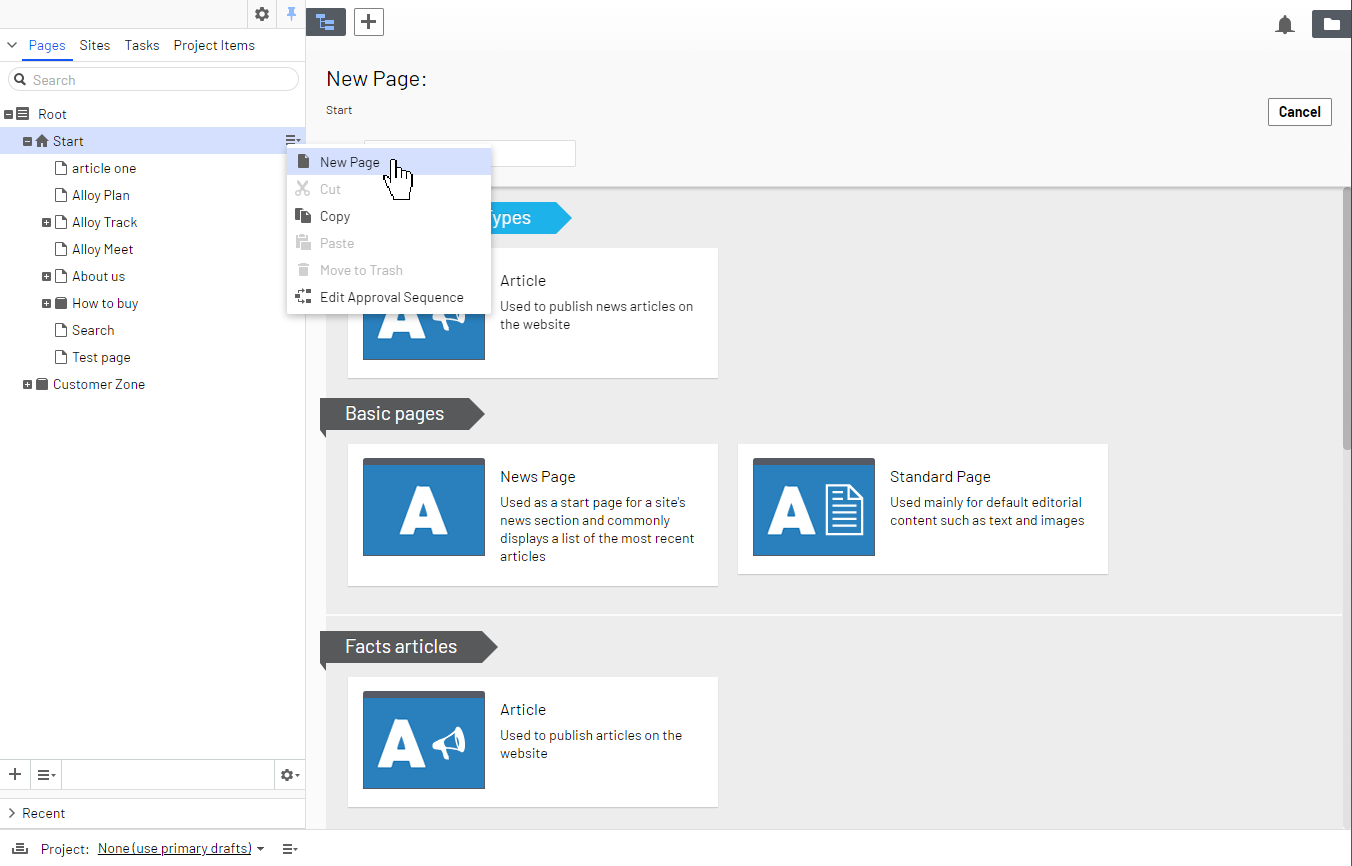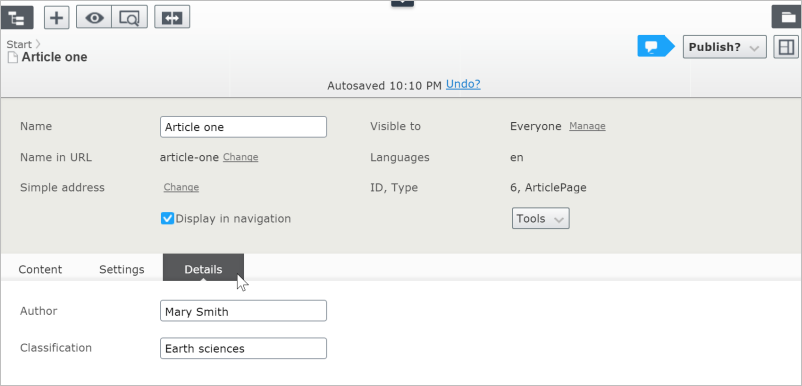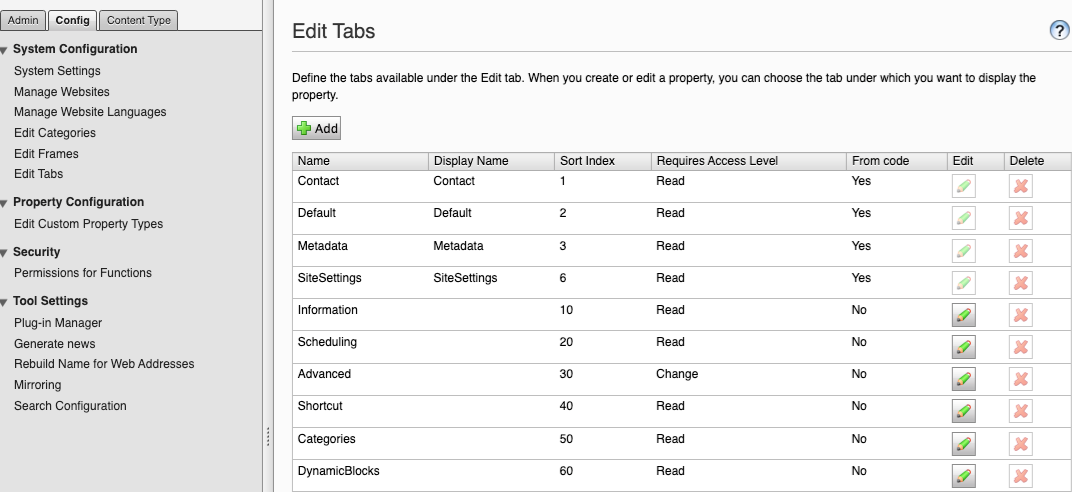Group content types and properties
Describes how to group content types and properties into logical entities, to make the editing experience more intuitive.
You can, for example, organize page types in groups to make it easier for editors to select the correct page type when creating pages in edit view. Properties can be grouped and ordered under tabs in the All Properties editing view.
Content types
To group content types, add the GroupName property to the contentType to specify a group, and use the Order property to determine the display order of the groups, such as when you create pages in the edit view and list content types in the admin view.
Example: Here you have two-page types – StandardPage and ArticlePage, belonging to the groups Basic pages and Facts articles, respectively, where the Basic pages group is displayed first because it has the lowest sort order.
[ContentType(GroupName = "Basic pages",
Order = 1,
DisplayName = "StandardPage",
GUID = "abad391c-5563-4069-b4db-1bd94f7a1eea",
Description = "To be used for basic content pages.")]
public class StandardPage: PageData {}
[ContentType(GroupName = "Facts articles",
Order = 2,
DisplayName = "ArticlePage",
GUID = "b8fe8485-587d-4880-b485-a52430ea55de",
Description = "Basic page type for creating articles.")]
public class ArticlePage: PageData {}
The result when creating a page in edit view:

You can also apply this to other types of content, such as products and variants in Optimizely Customized Commerce.
Properties
Properties can be grouped under tabs. Use the Display attribute to specify the GroupName that is displayed as a tab. The Order property controls the order of the displayed properties on the tab.
Example: The Article page has two properties – Author and Classification, which display under a tab named Details. The Author property is displayed first on the tab because it has the lowest sort order number.
[Display(
Name = "Author",
Description = "Name of article author.",
GroupName = "Details", Order = 1)]
public virtual String Author {
get;
set;
}
[Display(
Name = "Classification",
Description = "Genre or type of article.",
GroupName = "Details", Order = 2)]
public virtual String Classification {
get;
set;
}
The result when editing an article in the All Properties editing view:

Built-in groups
Optimizely Content Management System (CMS) provides a set of built-in tabs or groups for built-in properties. These built-in groups are only used for properties, not for content types. You can add your custom properties to the groups to make them display under the built-in tabs. Constants for the built-in tabs are defined in EPiServer.DataAbstraction.SystemTabNames.
| Name | Sort index | Description |
|---|---|---|
Content | 10 | A default group, used for properties that do not specify a group name. Note: The actual group name is Information. |
Settings | 30 | Used for some of the more advanced built-in properties. Note: The actual group name is Advanced. |
PageHeader | N/A | The page header is shown above the tabs or by scrolling up in the On-Page editing view. The actual group name is EPiServerCMS_SettingsPanel. |
The Content and Settings tabs are available by default. You can edit tabs from the CMS admin view. From here, you can also define access levels to create tabs with only properties available for selected editor groups.

Note
Tabs without properties will not be displayed in the All properties editing view. Scheduling, Shortcut, and Categories are obsoleted groups.
Use group definitions
You can define sort order on individual content types and properties as described. The order set indirectly defines the display order of content groups when you create content and shows the order of tabs when you edit content in the All Properties editing view.
When the number of content types and properties increases, it is convenient to define the order of groups at a higher level and then use order to sort among the content types and properties in each group. Normally, you define groups as a list of constants that you use in the DisplayAttribute.
Example: The Article page type with a News content type group, and a Contact tab with an Image property.
[ContentType(GroupName = GroupNames.News, Order = 1)]
public class ArticlePage: PageData {
[Display(GroupName = GroupNames.Contact)]
public virtual ContentReference Image {
get;
set;
}
}
public static class GroupNames {
public
const string News = "News";
public
const string Contact = "Contact";
}
You can also define the group names as constants in a separate class and decorate the class with the GroupDefinitions attribute (that CMS automatically picks up). You can define multiple classes with the GroupDefinitions attribute, but you can only define a single group name on one class. You cannot edit groups defined in the code in the admin view.
Set the order in which groups are displayed with the Display attribute. Properties and content types are sorted within each group by each order. Groups that have no order defined get Order=-1 and are displayed first.
Apply access levels
When you group content types and properties, you can apply access levels so that an editor must be part of a role, function, or other criteria to access the group. The required access level applies to groups of properties and groups of content types.
Example: The Contact group with access level set to Publish.
[GroupDefinitions]
public static class GroupNames {
[Display(GroupName = "MyNews", Order = 1)]
public
const string News = "News";
[RequiredAccess(AccessLevel.Publish)]
public
const string Contact = "Contact";
}
Override sort order of built-in groups
Groups without defined order will fall back to indirect sorting and have their sort index set to -1. You can override built-in groups to change the sort order.
Example: Override the default sort order for the Content tab.
[GroupDefinitions]
public static class GroupNames {
[Display(Order = 1000)]
public
const string Content = SystemTabNames.Content;
}
Note
You cannot edit groups that are defined in code from the admin view.
Updated 12 months ago